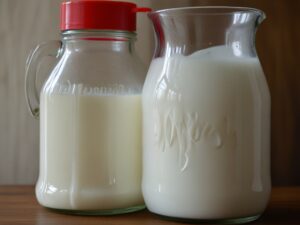If you have an ancestry of milk-drinkers, you may know the feeling of “milk hunger” which can only be satisfied by a glass of fresh milk. However, purchasing fresh milk can be expensive, not to mention the chore of remembering to stop and buy it regularly or resorting to expensive convenience stores. There are times when finding fresh milk becomes an impossible task, leaving one feeling like a desperate junkie searching the streets. So, why don’t people buy dry milk and reconstitute it at home? Is it a good life hack? Surprisingly, very few people seem to do it, even though dry milk is readily available in stores but predominantly marketed to bakers. In this article, we will explore the reasons behind this phenomenon and determine if reconstituting dried milk is a viable solution to the never-ending milk hunt.
The Convenience of Reconstituting Dried Milk: A Life Hack?
1. The Constant Chore: A glass of milk is a staple in many households. However, the need to replenish this essential item can become a repetitive and time-consuming chore. By purchasing dry milk and reconstituting it at home, one can eliminate the hassle of frequent trips to the store.
2. Cost-Effective Solution: Fresh milk often comes with a hefty price tag, particularly if bought from convenience stores. Reconstituting dried milk proves to be cost-effective, as one can save money by buying the dry alternative and preparing it as needed.
3. Availability: The frustration of not finding fresh milk when you need it can be overwhelming. Keeping a container of dry milk in your pantry ensures that you will never run out of milk, even if fresh supplies are scarce.
4. Extended Shelf Life: One of the major advantages of dry milk is its long shelf life. Unlike fresh milk, which spoils within a few days, dry milk can be stored for extended periods without compromising its quality or taste. This eliminates the fear of wasted milk and reduces the need for frequent grocery store visits.
Why Don’t People Reconstitute Dried Milk?
Despite the apparent benefits of reconstituting dried milk, it remains an uncommon practice among ordinary consumers. Several reasons contribute to this phenomenon:
1. Perception: Dry milk is often associated with baking or emergency food supplies rather than everyday consumption. The marketing and packaging of dry milk primarily target bakers, which may deter regular consumers from considering it as a viable option.
2. Taste and Texture: Some individuals may find the taste and texture of reconstituted dry milk less enjoyable compared to fresh milk. The distinct characteristics of reconstituted milk may not match the expectations and sensory experience that people have with fresh milk.
3. Convenience vs. Freshness: While reconstituting dried milk offers convenience, it may not satisfy the desire for the freshness and creaminess associated with fresh milk. For many milk enthusiasts, the experience of savoring a glass of chilled, freshly poured milk cannot be replicated by its reconstituted counterpart.
4. Lack of Awareness: Many people simply may not be aware of the benefits and versatility of reconstituting dried milk. The emphasis on fresh milk as the standard choice for consumption has overshadowed the potential advantages of its dry alternative.
5. Cultural Factors: Lastly, cultural norms and preferences also play a role in the popularity of reconstituted dried milk. In some cultures, drinking fresh milk holds significant cultural value and is deeply ingrained in traditions, making it unlikely for individuals to switch to dry milk.
FAQ: Reconstituting Dried Milk
1. Is reconstituted dried milk nutritious?
Yes, reconstituted dried milk retains most of the nutritional values present in fresh milk. It is a good source of protein, calcium, and vitamins.
2. How do you reconstitute dried milk?
To reconstitute dried milk, simply mix the specified amount of powder with water according to the instructions on the packaging. Stir well until the powder dissolves completely.
3. Can reconstituted dried milk be used for cooking and baking?
Absolutely! Reconstituted dried milk can be used as a substitute for fresh milk in various recipes, ranging from soups and sauces to baked goods.
4. Does reconstituted dried milk taste the same as fresh milk?
While reconstituted dried milk strives to replicate the taste of fresh milk, there may be a slight difference in flavor and texture. However, many people find the taste of reconstituted milk satisfactory for their needs.
5. How long can reconstituted dried milk be stored?
Reconstituted dried milk should be stored in the refrigerator and consumed within a few days to maintain its freshness. Always follow the specific storage instructions provided by the manufacturer.
Reconstituting dried milk presents a convenient and cost-effective solution to the everlasting “milk hunger” that many individuals experience. While it may not fully replace the sensory experience and cultural significance associated with fresh milk, it offers a viable alternative for those seeking convenience, extended shelf life, and affordability. So, next time you find yourself trolling the streets in search of fresh milk, consider giving dried milk a chance, and who knows, it might turn out to be your new milk-hunting hack!



